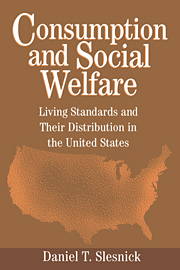Book contents
- Frontmatter
- Contents
- Acknowledgments
- 1 Introduction
- 2 The measurement of economic welfare
- 3 Measuring consumption: An initial look at the data
- 4 The cost of living
- 5 The standard of living
- 6 Does a rising tide raise all ships?
- 7 Consumption and poverty
- 8 Conclusions
- Appendix 1 Measuring individual and social welfare
- Appendix 2 Interpolating and extrapolating the expenditure distribution
- References
- Index
8 - Conclusions
Published online by Cambridge University Press: 10 December 2009
- Frontmatter
- Contents
- Acknowledgments
- 1 Introduction
- 2 The measurement of economic welfare
- 3 Measuring consumption: An initial look at the data
- 4 The cost of living
- 5 The standard of living
- 6 Does a rising tide raise all ships?
- 7 Consumption and poverty
- 8 Conclusions
- Appendix 1 Measuring individual and social welfare
- Appendix 2 Interpolating and extrapolating the expenditure distribution
- References
- Index
Summary
There is little doubt that family income is the predominant indicator of living standards and their distribution in the United States. The Bureau of the Census reports estimates of real median family income and the Gini coefficient of family income, and it tabulates poverty rates every year using survey data on income. These statistics show a stagnant standard of living, rising inequality, and persistent poverty.
Although it is widely used, I've noted repeatedly that there is little basis in economic theory for using income as a measure of welfare. The standard theoretical paradigm of consumer behavior describes households as constrained utility maximizers, where utility is a function of the goods and services consumed. This implies that, for a “snapshot” estimate of the standard of living, the relevant summary variable is total expenditure rather than income. Moreover, there are reasons to believe that consumption provides a more accurate proxy for intertemporal well-being.
I've shown that consumption-based welfare measures provide a distinctly different perspective on the evolution of living standards and their distribution in the postwar United States. Using established principles of welfare economics and alternative data sources, the picture that emerges is much more optimistic. In this concluding chapter, I summarize the key findings and highlight their differences from the stylized facts that are based on tabulations obtained using income data.
THE COST OF LIVING
Changes in the cost of living are most commonly measured using the CPI despite increasing evidence of sustained, systematic upward biases in the estimates of inflation.
- Type
- Chapter
- Information
- Consumption and Social WelfareLiving Standards and their Distribution in the United States, pp. 190 - 200Publisher: Cambridge University PressPrint publication year: 2000



